Last week I received an email alert from my friend Art S. Revolutionary, publisher and editor of the MUSEA ‘zine and blog, announcing that the fabled Technicolor film lab is closing its doors in Glendale, CA. Oh, Technicolor isn’t going out of business necessarily, but as the movie industry shifts to digital production and/or presentation, there is less and less of a need for film prints, the bread and butter of Technicolor lo these many decades.
Of course, even before the the rise of digital technology, the nature of Technicolor had changed significantly from its heyday in the 1930s, ’40s, and ’50s. Beginning with 1935’s Becky Sharp, Technicolor entailed using an elaborate three-strip process, that is, three strips of black-and-white film running simultaneously through one specialized camera equipped with a prism, all of it supervised by the people at the Technicolor labs. To clarify, studios did not own their own Technicolor cameras, rather they leased them, and when they did, they did so under the watchful eye of Technicolor personnel who apparently were on-set day in and day out to protect both their property and their brand. (Oh, and, yes, I’ve greatly simplified the process, but please feel free to explore the links to further reading I’ve supplied at the end of this piece.)
By the mid 1950s, Technicolor introduced a less cumbersome and less expensive process which still produced fantastic results, per the likes of To Catch a Thief (1955), Vertigo (1958), Ben-Hur (1959), West Side Story (1961), Lawrence of Arabia (1962), My Fair Lady (1964), and Mary Poppins (1964), though purists still insist the full-bloom of the Technicolor magic was lost, meaning loss of depth, loss of resolution, etc. That loss continues with the reliance on digital production. Yes, turning away from pure celluloid is a democratic move as it means more and more people can make the movies of their dreams. Indeed, a friend of mine in New York City is excited about the prospect of making his own dream project a reality, and I’m certainly rooting for him. Plus, the quality of digital recording has come a long, long way as the price has fallen. Look no further than 2013’s Oblivion and Gravity. That noted, no less than Christopher Nolan (The Dark Knight and Inception) still holds that film produces superior, more satisfying imagery.
Here are some of our favorites from the classic three-strip era:
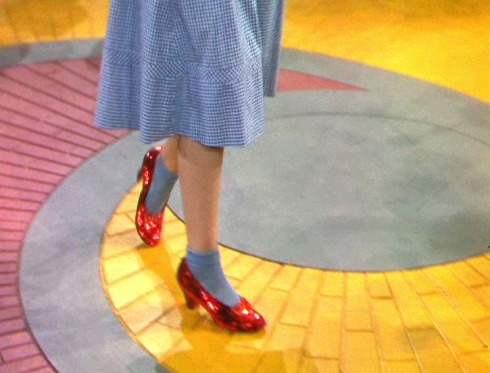
^ I honestly think it doesn’t get any better than this: the primary colors, red, blue, and yellow, captured in a single shot in 1939’s classic The Wizard of Oz. Heaven. As much as I respect the tremendous amount of talent, skill, and effort in the same year’s blockbuster Gone with the Wind, I think The Wizard of Oz makes better use of Technicolor’s properties. Star Judy Garland found additional Technicolor greatness in Meet Me in St. Louis (1944) and A Star is Born (1954), among others.
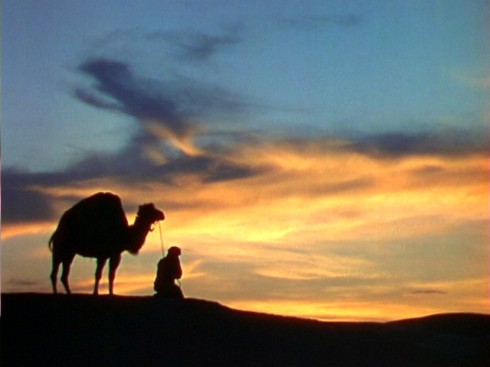
Lawrence of Arabia? Nope. It’s 1936’s glorious The Garden of Allah, starring Charles Boyer and Marlene Dietrich. The film won a special Oscar for its cinematography (W. Howard Greene and Harold Rosson) as black and white was still standard, and color was considered a rare and exotic thing. Separate categories for color/b&w cinematography, art direction, and costumes would not be introduced for a few more years though even then black and white films outnumbered those in color. The Garden of Allah, by the way, is my hubby’s #1 Technicolor pick. (PHOTO: Lassothemovies.com)
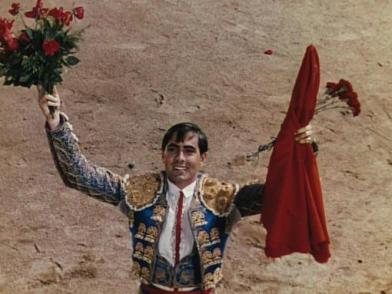
I’d read about director Rouben Mamoulian’s Blood and Sand (1941) for ages before I actually saw it. We had a VHS copy for years but have not yet updated our collection. The film, which stars Tyrone Power, Rita Hayworth, Anthony Quinn, and Dallas’s own Linda Darnell, won Oscars for its team of cinematographers, Ernest Palmer and Ray Rennahan. Unfortunately, there are almost no photos available online that show the movie’s true beauty. A professor friend of mine, a mentor, is writing about this movie’s use of color. (PHOTO: Immortal Ephemera)
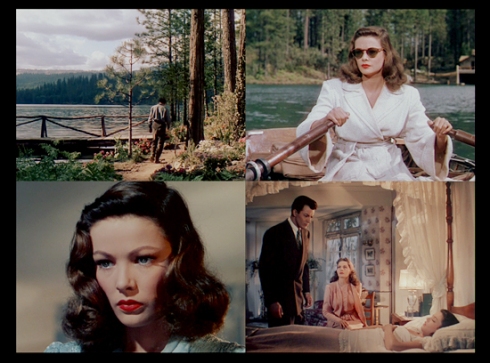
Beautiful Gene Tierney earned her only Oscar nod for her starring role in 1945’s lush Leave Her to Heaven, a dizzying technicolor spin on film noir which earned Leon Shamroy that year’s Academy Award for Best Color Cinematography. (PHOTO: Old Projection Room/tumblr)
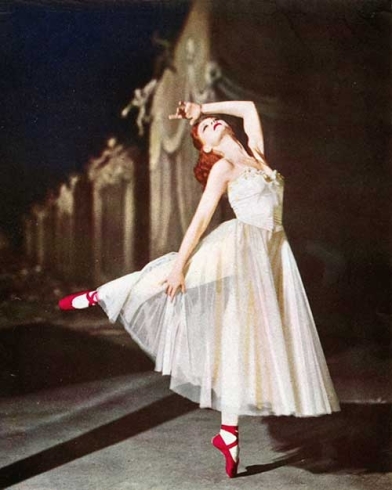
Some film connoisseurs hail Michael and Powell and Emeric Pressburger’s Black Narcissus (1947) as the most impressive Technicolor film ever made, and, true enough, cinematographer Jack Cardiff won an Oscar, but I much prefer, as I wrote in either my first or second blog piece, the directing duo’s The Red Shoes (1948) starring Moira Shearer (above) and Anton Walbrook. No one can deny this hugely popular movie’s staggering beauty, but cinematographer Jack Cardiff was glossed over for Academy consideration though the film was up for Best Picture and actually won Best Art Direction/Set Decoration honors for Hein Heckroth and Arthur Lawson. Of course, my thought is that all those design elements stand out precisely because of Technicolor in the first place. Per the IMDb, Technicolor founders Herbert & Natalie Kalmus championed The Red Shoes as their supreme achievement though they also reportedly fought with Cardiff, and that might have played a part in Cardiff’s snub, that or the fact that he had just won a year earlier.

A year ago I included Cecil B. DeMille’s Samson and Delilah (1949), starring Hedy Lamarr (center) and Victor Mature (right), on my movie bucket list. Now, I cherish my own completely legit copy, and while no one will ever extol this extravaganza as great art, the colors most certainly pop, especially the blues, greens, and purples. The movie won Oscars for art direction and costume design while cinematographer George Barnes, though in the race, was outpaced by Robert Surtrees (King Solomon’s Mines). Note: All available reference materials tag Samson and Delilah as a 1949 release though it actually competed in the 1950/51 Oscar race. (PHOTO: DVD Talk)
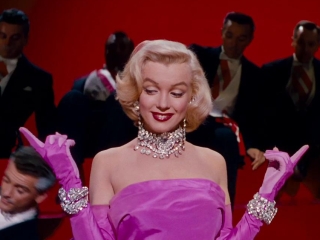
Omg, how insane are the color schemes in 1953’s Gentlemen Prefer Blondes starring the one and only Marilyn Monroe? Who pairs fuchsia and deep, deep red? Unconventional, sure, but it looks like a million bucks–Technicolor as its most delightfully garish–as does the opening “Two Little Girls from Little Rock” number with Marilyn and topped billed Jane Russell, smashing in red sequins against a violet-blue background. Even so, and even with Marilyn’s iconic “Diamonds Are a Girl’s Best Friend,” the Academy stayed away, but the rest of us can still enjoy the fun. (PHOTO: Rotten Tomatoes)

Meanwhile, the 1953 Oscar for Best Color Cinematographer went to Shane’s Loyal Griggs, another stunning Technicolor winner. (PHOTO: Dave Wessels ComiX)

Michael and I stumbled upon the candy colored hokum of This Island Earth (1955) several years ago. It was apparently Universal’s first sci-fi offering filmed in color, that is, Techicolor; however, I believe this was likely not shot using the three-strip process, but who cares?
Of course, I could go on all day, what with the likes of The Adventures of Robin Hood (1938), Annie Get Your Gun (1950), An American in Paris (1951), The African Queen (1951), Singin’ in the Rain (1952), The Quiet Man (1952), and 20,000 Leagues Under the Sea (1954), as well as The Ten Commandments (1956), not to mention a few Disney animated classics, such as Snow White and the Seven Dwarfs (1937) and Cinderella (1950). Don’t ask me how these animated films were filmed using Technicolor. I’m just the reporter. Esther Williams’ aquatic spectacles, such as Oscar nominated Million Dollar Mermaid (1952), also presented challenges since portions of Williams’s movies were shot in water-filled tanks. Oh, and don’t forget Ziegfeld Follies (1945) featuring Lucille Ball, known in those days as ‘Techinicolor Tessie’ thanks to her flaming red hair and big blue eyes–never seen to better advantage.
Over the course of researching this article, I’ve discovered that some of my faves weren’t even filmed in the simplified version of Technicolor as innovations in technology allowed studios to work their own magic. For example, Giant (1956) was filmed in WarnerColor, and Gigi (which I prefer to, say, An American in Paris) was filmed in Metrocolor. Universal’s popular Ross Hunter/Douglas Sirk version of Imitation of Life (1959) starring Lana Turner was in Eastman Color; moreover, 1954’s terrific mystery The Black Widow, starring Van Heflin, Ginger Rogers, and Gene Tierney, was filmed using “Color by De Luxe,” but, trust me, it’s as plush and eye-catching as Technicolor at its snazziest. The Black Widow was a 20th Century Fox offering as are other choice De Luxe entries such as The King and I (1956, another one of Michael’s picks), An Affair to Remember (1957), and The Sound of Music (1965), along with Three Coins in a Fountain and The Best of Everything, both of them highly entertaining “career girl” flicks that offer equal doses of newfangled romance and old-fashioned morality. Of course, once single strip color film became available–and less expensive than the old three strip method–it all but spelled the end for black and white films and, arguably, gave movies an advantage over television.
Even though, as the old saying goes, “They don’t make ’em like they used to,” that doesn’t mean that good movies–with amazing visuals–aren’t still being made in Hollywood. They are, and they will continue to be; nonetheless, it’s hard not to get nostalgic about the end of this most robust, and yes colorful, passage of old school filmmaking.
Okay, that’s my two-cents. Now, I’d love to hear from you. What are some of your favorite color films from Hollywood’s Golden Age? What recent movies did you love for their eye-popping visuals?
Thanks for your consideration.
Further reading:
“Technicolor Shutters Glendale Lab as Film Fadeout Continues” by David S. Cohen in Variety, featuring quotes from Chris Nolan: http://variety.com/2013/film/news/technicolor-shutters-glendale-lab-as-films-fadeout-continues-1200981010/
“Filmmakers Lament Extinction of Film Prints” by Andrew Stewart and David S. Cohen in Variety: http://variety.com/2013/film/news/film-jobs-decline-as-digital-distribution-gains-foothold-1200375732/
Natalie Klamus on The Red Shoes at the Internet Movie Database: http://www.imdb.com/title/tt0040725/trivia?ref_=tt_ql_2
“The Rise of Technicolor” in the Los Angeles Times: http://articles.latimes.com/1998/dec/04/entertainment/ca-50659
“Fabulous Technicolor! A History of Low Fade Color Print Stocks” by Les Paul Robley: http://www.in70mm.com/news/2010/technicolor/
“The ‘Tech’ Behind Technicolor: The Advent of Classic Color Films” by John Cunningham, 1997: http://www.reelclassics.com/Techtalk/technicolor-article.htm
“Technicolor Adventures in Cinemaland” by Technicolor founder H.T. Kalmus: http://www.widescreenmuseum.com/oldcolor/kalmus.htm
‘Technicolor Camera” by Martin B. Hart at the American Widescreen Museum: http://www.widescreenmuseum.com/oldcolor/big_camera_pic.htm
“Happy Birthday Natalie Kalmus, Queen of Technicolor” by Anne Marie: http://werecyclemovies.com/2013/04/09/happy-birthday-natalie-kalmus-queen-of-technicolor/


Great piece! Well done!